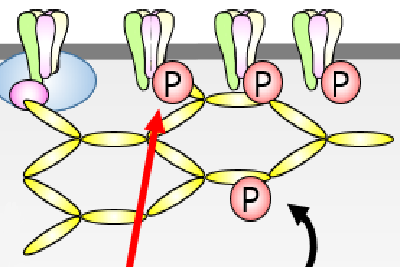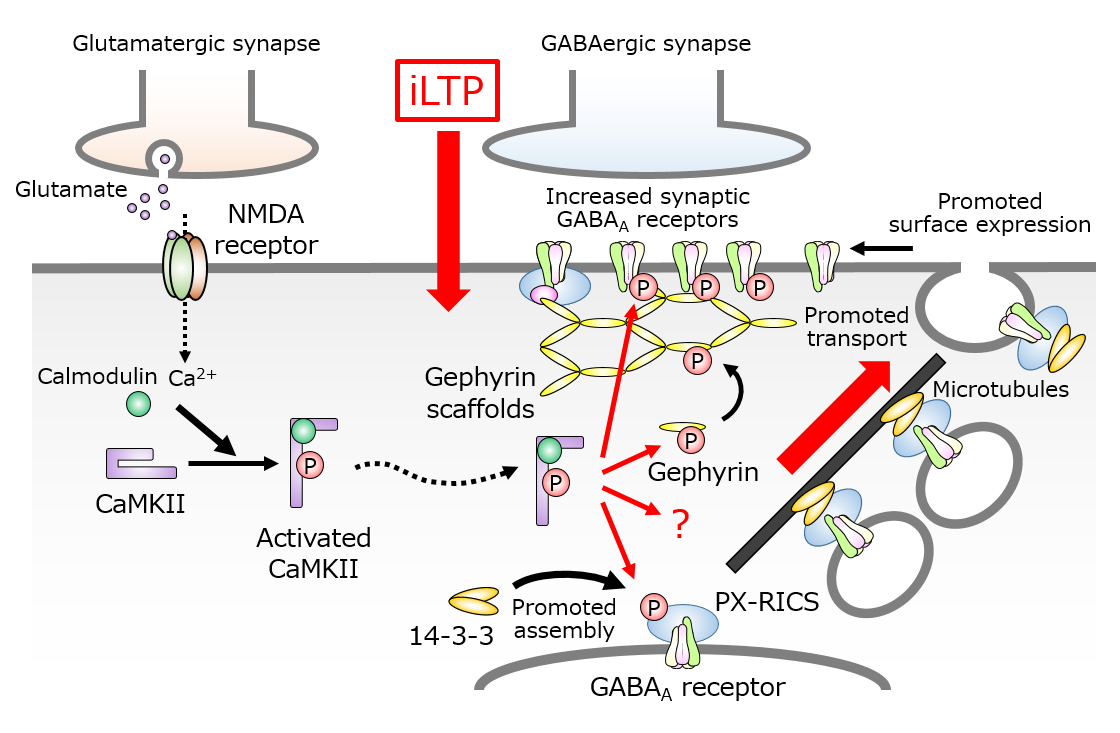Impaired emotional learning underlying autism PX-RICS seen as molecular link between emotion and autism


Moderate stimulation of NMDA receptors induces limited Ca2+ influx and preferential activation of CaMKII. Activated CaMKII translocates to inhibitory synapses, where it phosphorylates target proteins such as gephyrin and the GABAA receptor β3 subunit. CaMKII also phosphorylates PX-RICS to promote GABAA receptors transport to the neuronal surface, resulting in a persistent increase in the number of synaptically confined GABAA receptors and inhibitory synaptic transmission (inhibitory long-term potentiation, or iLTP). GABAergic activity and plasticity within the amygdala plays critical roles in emotional function such as fear learning. Dysfunction of PX-RICS–dependent GABAA receptor transport leads to improper emotional processing in the amygdala, resulting in autistic-like social behavior.
© 2018 Tsutomu Nakamura.
Emotion includes not only primary emotions comprising fear, anger, joy, sadness, surprise and disgust, but also social cognitive functions by which a person infers mental states of others and deduces their intentions from their attitudes. It is an important constituent of the human mind that determines a person's social behavior arising from the functions of neurons in the brain region called the amygdala. The onset of autism is thought to be closely tied to the dysfunction of the amygdala, but the molecular mechanisms linking the impaired function of the region to autistic behavior are not well-understood.
A team of researchers led by Visiting Associate Professor Tsutomu Nakamura and Project Professor Tetsu Akiyama at the Institute for Quantitative Biosciences at the University of Tokyo has explored the physiological functions of the autism-related protein PX-RICS, and demonstrated that it plays an essential role in carrying out emotional learning in the amygdala.
PX-RICS is a neuron–enriched protein that is involved in the intracellular transport of proteins called GABAA receptors to the neuron's surface. Based on the observation that PX-RICS is abundantly expressed in the amygdala, the researchers assessed the emotional function of mice that lack the PX-RICS gene, which exhibit various autistic-like social behavior. Fear conditioning is known to be inversely correlated with the severity of autism and depends on GABA-related activity and plasticity within the amygdala. In a fear-conditioning test, the researchers found that PX-RICS–deficient mice had significantly decreased ability in fear learning prompted by the amygdala. Considering their findings, the scientists reasoned that dysfunction of PX-RICS–dependent GABAA receptor transport leads to improper emotional processing in the amygdala, resulting in social behavior resembling autism.
Recent studies sequencing all the protein-coding regions in the genome, known as the exome, have revealed alterations of the PX-RICS gene not only in cases of autism, but also in schizophrenia and alexithymia, the inability to recognize and describe emotions. These data strongly suggest that PX-RICS–dependent GABAA receptor transport, if impaired, seriously affects socio-emotional processing in the brain. Further elucidation of the functional link between PX-RICS and the amygdala could lead to a better understanding of factors leading to the development of autism and provide insights into its treatment.
"We have a molecular clue for understanding GABA signaling, amygdala function and autism pathogenesis comprehensively," says Nakamura. He continues, "Impaired emotional function of the amygdala is closely related to atypical social behavior and social communication often found in autistic individuals. It is really exciting that the findings from our basic research led to the elucidation of the mechanism in our brain that gives rise to autism. There are many issues that still need to be resolved, but we will aim to develop a novel therapeutic strategy for autism targeting GABA signaling."
Papers
Tsutomu Nakamura, Fumika Sakaue, Yukiko Nasu-Nishimura, Yasuko Takeda, Ken Matsuura, Tetsu Akiyama, "The autism-related protein PX-RICS mediates GABAergic synaptic plasticity in hippocampal neurons and emotional learning in mice," EBioMedicine, doi:10.1016/j.ebiom.2018.07.011.
Link (Publication )
)





